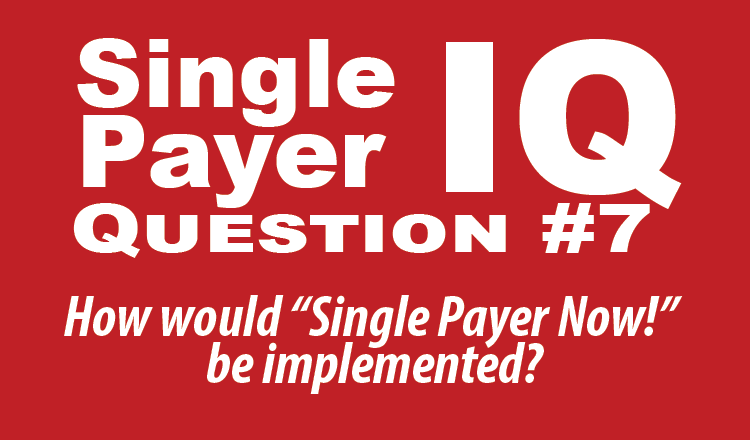Single Payer IQ Test Question # 7: How would “Single Payer Now” be implemented?
Answer: Even Vermont hasn’t been able to figure this out.
Agitators carrying “Single Payer now!” signs need to do a thought experiment on how the program would be implemented. A radical restructuring of a $3 trillion enterprise can hardly be done instantly. The Vermont prototype, Green Mountain Care, was enacted in 2011 and cancelled by its chief proponent, Gov. Peter Shumlin, in 2014 because of cost. An 11.5% payroll tax on businesses and an income tax up to 9.5% was considered too costly to pass. And if it had passed, people and businesses might have fled to a neighboring state.
With a national Medicare-for-all program, the tax would not be so easy to flee. Moreover, the federal government has the seemingly unlimited ability to create fiat money and incur debt.
The legislature chose a team of consultants to design the model, led by health economist William Hsiao, who had advised the nation of Taiwan during its transition to a single-payer system—and was the architect of the Resource-Based Relative Value Scale (RB-RVS) for setting Medicare fees. Also involved was Jonathan Gruber, well known for his work on “RomneyCare” and the Affordable Care Act (ACA or “ObamaCare”), especially the “Cadillac tax.”
The plan was to be a “public-private partnership,” with all decisions including benefits, coverage, and premiums to be decided by a five-member Green Mountain Care Board.
The plan would not be encumbered by the promise: “If you like your health plan, you can keep your health plan.” Despite that promise, ACA has provided a lot of experience in termination of health plans. As to funding, the idea is to funnel all current spending, public and private, into the system. Federal spending alone, as tabulated below, is about the same as Bernie Sanders’s estimate for the entire cost of his plan: $1.38 trillion/yr (42% of federal tax revenue of $3.3 trillion).
Yet “Bernie’s plan means no more copays, no more deductibles and no more fighting with insurance companies when they fail to pay for charges,” it is claimed. The reason why Medicare for all will supposedly cost no more than the federal government is now spending for only certain populations is the claimed huge savings on advertising and insurers’ overhead and profits.
Increased taxes, Sanders asserts, would be offset by less private spending. Apparently, employee health benefits would get funneled to the Green Mountain Care Board’s federal equivalent instead of to commercial insurers, and individuals’ medical dollars would go (via government) to the Board instead of to insurers, physicians, hospitals, and clinics. Then the Board would pay for all care.
What would happen to the people who now receive this money, and to insurance companies’ assets and stockholders? That’s left as an exercise for the student.
Doctors, clinics, and hospitals could only bill the single payer. Vermont physicians said that Green Mountain Care would end patients’ rights to engage the physician of their choice. In Quebec, Canada, the shining model for single payer, Dr. Jacques Chaoulli sued over the right of patients to purchase care outside the system. After a long, costly battle, the court ruled that access to a waiting list was not access to care. [1]
Sen. Sanders for 20 years has been saying it is “high time to establish a tax on wealth similar to those that exist in most European countries.” A political opponent said: “Sanders’ European-style wealth tax ‘covers’ everything they own every year. Every tractor, cow, and acre.”
The details on how to disrupt all existing relationships involving both medical care and its financing throughout the U.S., in order to funnel the prescribed portion of the assets possessed by employers and individuals into “health care for all,” and to subject everyone to the determinations of an appointed “public-private partnership” are apparently to be left to the experts like Hsaio and Gruber.
The possible outcome of turning the U.S. into Venezuela [2] is not considered.
| Federal program | Cost in 2016 |
| Medicare (over 65) | $612 billion |
| Tax deductions for health insurance | $272 billion |
| Medicaid (non-ACA expansion) | $203 billion |
| Medicare (under 65) | $80 billion |
| Medicaid (ACA expansion) | $64 billion |
| Veterans health care | $63 billion |
| ACA marketplace subsidies | $43 billion |
| ACA premium tax credits | $32 billion |
| Children’s Health Insurance Program | $13 billion |
| Total | $1,380 billion |
Take-home Lessons:
- The current plan for implementation of single payer exists only in virtual reality.
- The only possible “now” in “single payer now” would be the destruction of existing relationships, institutions, and wealth.
References:
- Chaoulli J. The long road to freedom in Canadian medicine. J Am Phys Surg 2005;10:91-92. Available at: http://www.jpands.org/vol10no3/chaoulli.pdf.
- Huntoon LR. The bitter fruit of socialism: health crisis in Venezuela. J Am Phys Surg 2017;22:34-35. Available at: http://www.jpands.org/vol22no2/huntoon.pdf.
Printable PDF of Question #7: https://goo.gl/4rwVTM
Single Payer IQ Test Question Archive: https://aapsonline.org/category/hcriq/




